Understanding stakeholders is critical to the success of any project. A stakeholder map helps project managers visualize who is involved, their influence and their level of interest in the project. By mapping stakeholders effectively, teams can prioritize engagement, anticipate challenges and allocate resources efficiently. Using stakeholder map examples can guide new managers in creating their own maps tailored to their projects.
Stakeholder map examples vary depending on project size, industry and complexity. Some maps focus on influence versus interest, while others categorize stakeholders by role, department or communication needs. Examining different examples provides insights into strategies for engagement, risk management and communication planning, helping teams make informed decisions and improve project outcomes.
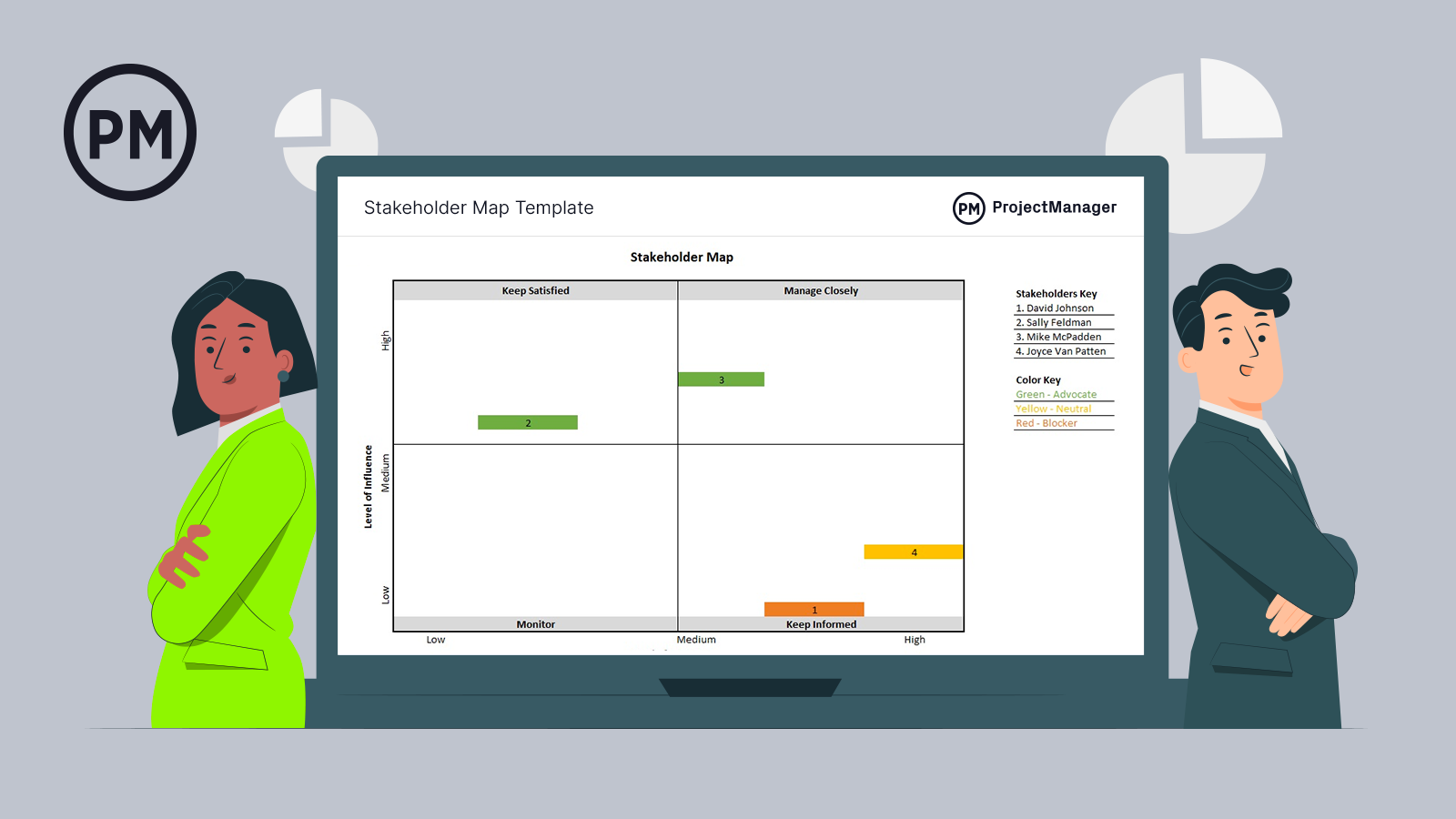
Get your free
Stakeholder Map Template
Use this free Stakeholder Map Template to manage your projects better.
Get the Template
Project management software streamlines stakeholder management by centralizing information, tracking communication and visualizing relationships. Managers can assign responsibilities, set notifications and monitor interactions to ensure stakeholders are informed and engaged. Software features like dashboards, reporting and task tracking allow teams to measure stakeholder impact and adjust engagement strategies in real time, reducing misunderstandings and improving collaboration.
ProjectManager provides the tools to manage stakeholders efficiently using multiple project views, real-time dashboards and comprehensive tracking. Gantt charts visualize timelines and dependencies, making it easy to see how stakeholder actions influence project progress. Task lists, kanban boards and resource management features ensure all interactions are accounted for and team responsibilities are clear. Use unlimited guest licenses for stakeholders who need to see the progress of work without taking action on tasks or projects. Our software helps stakeholder management stay organized and proactive. Get started with ProjectManager today for free.
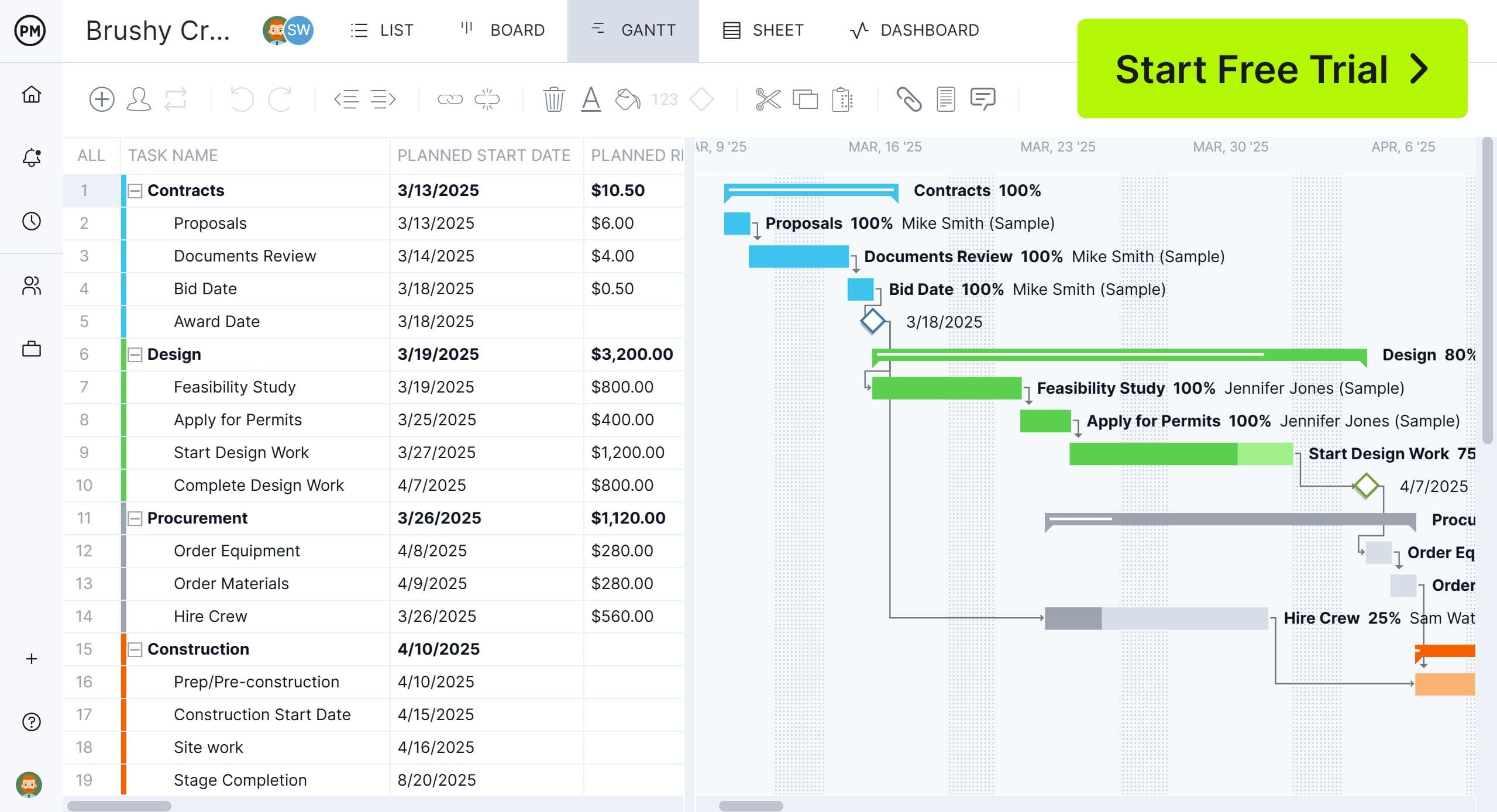
1. Residential Construction Project Stakeholder Map Example
The Oakwood Estates project is a large-scale residential construction initiative designed to create a sustainable and modern housing community in a rapidly growing suburban area. The project team faces the challenge of coordinating multiple contractors, suppliers and designers while ensuring the development meets local building codes and environmental regulations. Residents expect high-quality finishes, well-planned layouts and minimal disruption during construction. From the start, project managers need to balance competing priorities: maintaining a strict construction timeline, staying within budget and managing the expectations of a diverse set of stakeholders.
Homebuyers are naturally the most invested group, seeking assurance that their future homes will be completed on time and to specification. Their influence is medium because, while they cannot directly control construction decisions, their feedback and complaints can create pressure points. Local government and building inspectors have high influence, as approvals, inspections and permits can make or break schedules.
Neighborhood associations and community groups, although having low influence, are important for community buy-in and addressing potential complaints about noise, traffic or environmental impacts. Contractors and subcontractors are central to the project’s execution; their schedules, resource allocation and quality control practices directly affect timelines and outcomes.
Related: 20 Free Excel Construction Templates
The project team implements stakeholder engagement strategies such as regular progress meetings, newsletters, and dedicated communication channels. By creating a stakeholder map, managers can clearly see who requires close management, who should be kept satisfied and who simply needs monitoring. This approach helps anticipate potential conflicts before they arise, such as a subcontractor shortage or a permit delay and enables proactive planning.
The narrative of Oakwood Estates illustrates how residential construction projects require a careful balance between technical execution, community relations and customer satisfaction. Successfully navigating these dynamics not only ensures on-time delivery but also establishes trust with homeowners, the community and regulators.
| Stakeholder Group | Level of Interest | Level of Influence |
| Homeowners / Buyers | High | Medium |
| Local Government / Inspectors | Medium | High |
| Contractors / Subcontractors | High | High |
| Neighborhood Associations | Medium | Low |
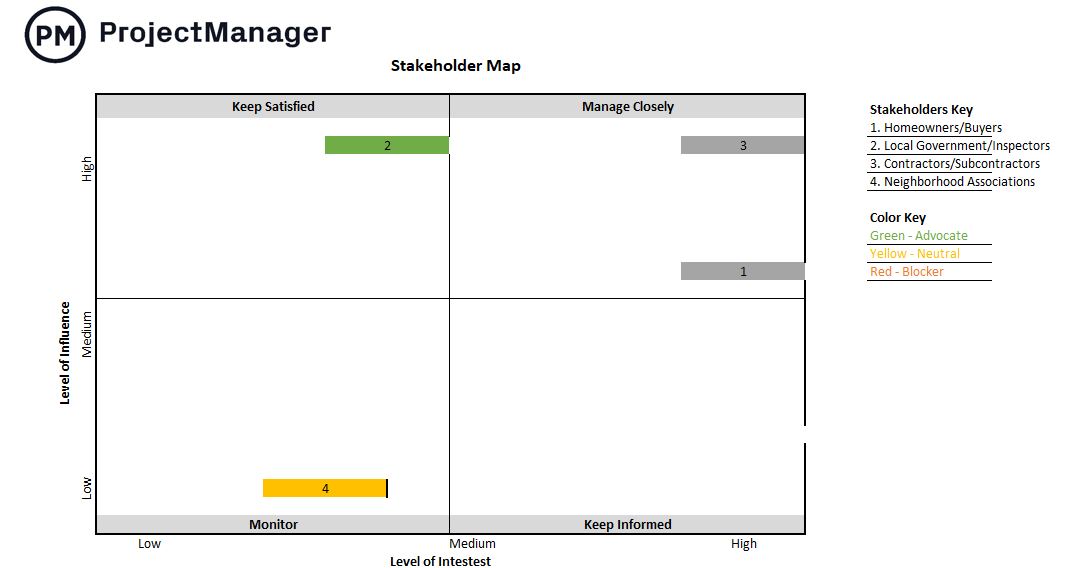
2. Industrial Construction Project Stakeholder Map Example
The GreenTech Manufacturing Plant project entails constructing a state-of-the-art facility capable of producing environmentally friendly products on a large scale. This industrial construction project presents a complex array of technical, regulatory and logistical challenges. Project managers must coordinate with engineers, environmental regulators, suppliers and internal management to ensure the plant meets strict safety and efficiency standards. Each stage, from laying the foundation to installing specialized machinery, requires careful oversight to prevent delays, cost overruns and regulatory violations.
Related: Construction Schedule Template
Company management is highly interested and highly influential because they provide funding, define project goals and make key strategic decisions. Construction engineers have high interest but medium influence; they manage the technical execution of the project and ensure that safety and quality standards are maintained. Environmental agencies have medium interest but high influence, as their approvals and compliance audits directly affect the project’s timeline and feasibility. Finally, local labor unions and workforce representatives have medium interest and medium influence, ensuring that employment practices and working conditions meet legal and contractual standards.
The story of the GreenTech Plant underscores the importance of stakeholder mapping in industrial projects, where misalignment between engineering teams, regulators and management can result in costly delays. Regular coordination meetings, transparent reporting and a clear stakeholder map help managers anticipate conflicts and streamline decision-making.
By analyzing stakeholder influence and interest, the project team can focus resources where they are most impactful, such as prioritizing approvals from regulatory bodies and maintaining strong communication with company executives to align expectations. Industrial construction projects, therefore, demonstrate the critical balance between operational efficiency, regulatory compliance and workforce management.
| Stakeholder Group | Level of Interest | Level of Influence |
| Company Management | High | High |
| Construction Engineers | High | Medium |
| Environmental Agencies | Medium | High |
| Local Workforce / Unions | Medium | Medium |
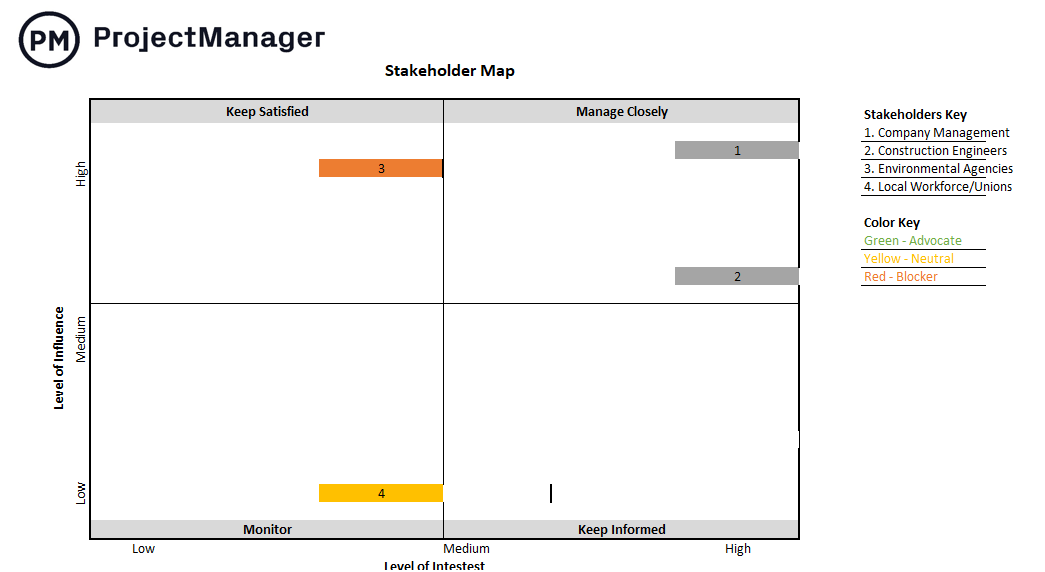
3. Commercial Construction Project Stakeholder Map Example
The Central City Shopping Center project is a high-profile commercial construction endeavor in a dense urban environment. The project involves multiple retail tenants, investors, contractors and city authorities. Project managers must carefully coordinate construction schedules to minimize disruption to surrounding businesses, maintain safety standards and ensure tenant requirements are met.
Each stakeholder brings a unique set of expectations and pressures. Retail tenants are focused on store readiness, layout and design, while investors are concerned with return on investment, lease agreements and cost management. City planning departments enforce zoning, safety and accessibility regulations that can affect timelines and construction methods. The general public and local customers, though less influential, provide feedback that shapes design decisions and amenities.

Effective stakeholder engagement is crucial. Managers must communicate timelines, construction impacts and updates clearly and consistently. The project team uses stakeholder mapping to identify which stakeholders require close attention, which should be kept satisfied and which simply need periodic updates. By mapping influence and interest, the project team can anticipate challenges, such as unexpected city regulations, tenant design requests or delays from subcontractors.
The Central City Shopping Center narrative illustrates how commercial projects must integrate stakeholder management with construction planning to deliver a facility that meets both business and community expectations. The complexity of multiple tenants and urban restrictions highlights the value of visualizing stakeholder dynamics to avoid delays, miscommunication, or cost overruns.
| Stakeholder Group | Level of Interest | Level of Influence |
| Retail Tenants | High | Medium |
| Investors / Developers | High | High |
| City Planning Department | Medium | High |
| Local Customers | Medium | Low |
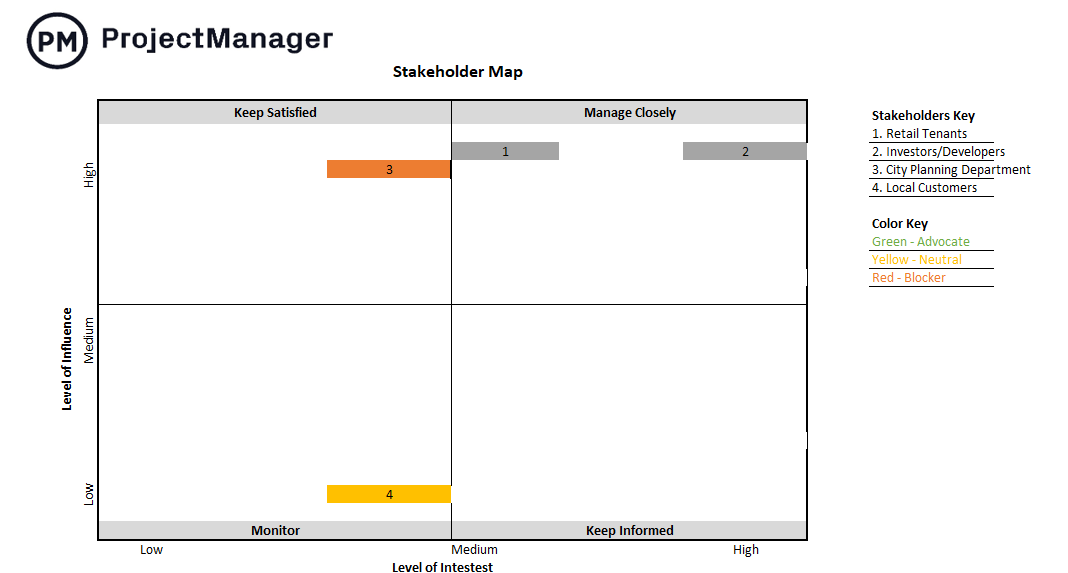
4. Manufacturing Project Stakeholder Map Example
The Phoenix Electronics production line expansion is a strategic manufacturing project aimed at increasing output without disrupting existing operations. The project involves multiple teams: operations managers who oversee production efficiency, supply chain specialists who ensure timely delivery of materials, quality assurance personnel who maintain product standards and production staff executing daily operations. Each stakeholder group has unique priorities and responsibilities, and the project manager must coordinate these efforts to minimize risk and maximize efficiency.
Operations managers are highly interested and highly influential, guiding workflow and resource allocation. The supply chain team is highly interested but has medium influence, as delays in material procurement can ripple across the production line. Quality assurance personnel are medium interest but high influence, ensuring compliance and preventing defects that could damage the company’s reputation. Production staff have medium interest and medium influence, as their daily execution affects output quality and timeliness.

The narrative emphasizes how manufacturing projects require careful coordination and proactive stakeholder engagement. A stakeholder map allows managers to visualize relationships, prioritize communication and anticipate problems, such as production bottlenecks or supply delays. Phoenix Electronics’ expansion demonstrates that successful manufacturing projects depend not only on technical execution but also on understanding stakeholder needs and influence. By integrating stakeholder mapping into project planning, managers can reduce risks, maintain quality and achieve efficient production outcomes.
| Stakeholder Group | Level of Interest | Level of Influence |
| Operations Managers | High | High |
| Supply Chain Team | High | Medium |
| Quality Assurance | Medium | High |
| Employees / Production Staff | Medium | Medium |

5. Government Project Stakeholder Map Example
The Riverfront Community Center project is a public infrastructure initiative designed to serve the needs of the local community. Project managers must navigate a highly complex stakeholder environment involving civic leaders, the general public, contractors and regulatory agencies. Each group has different expectations: civic leaders prioritize budget adherence, regulatory compliance and public approval; the public seeks accessibility, amenities and timely completion; contractors focus on executing tasks efficiently; and regulatory agencies enforce building codes and safety regulations.
Related: 10 Free Task Management Templates
Civic leaders are highly interested and highly influential, approving budgets and making key decisions. The general public is highly interested but medium influence, providing feedback and support that can affect political or funding decisions. Contractors and vendors are medium interest but high influence, as their performance directly impacts schedule and quality. Regulatory agencies are medium interest but high influence, ensuring safety and legal compliance.
The story of the Riverfront Community Center highlights the challenges of balancing public expectations, regulatory requirements and construction realities. Stakeholder mapping helps the project team prioritize engagement, assign responsibilities and plan communication strategies that satisfy all parties. By visualizing influence and interest, managers can anticipate conflicts, mitigate risks and ensure that the project is completed successfully. Government projects demonstrate how stakeholder management is critical for transparency, accountability, and community satisfaction.
| Stakeholder Group | Level of Interest | Level of Influence |
| Civic Leaders / Officials | High | High |
| General Public | High | Medium |
| Contractors / Vendors | Medium | High |
| Regulatory Agencies | Medium | High |

Stakeholder Map Template
Download this free stakeholder map template to identify and categorize stakeholders based on their level of interest and influence in a project. Typically presented as a four-quadrant matrix, this template helps project managers prioritize stakeholders and tailor engagement strategies accordingly. By plotting stakeholders into categories such as “Manage Closely,” “Keep Satisfied,” “Keep Informed” and “Monitor,” teams can allocate resources effectively and ensure that communication efforts are aligned with stakeholder needs and expectations.
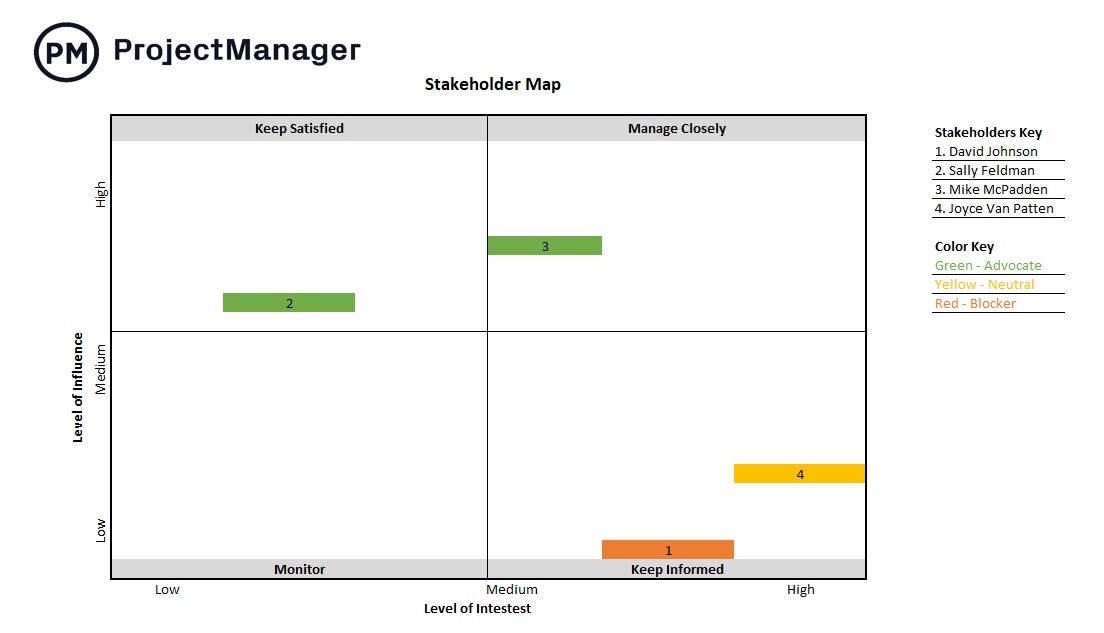
Utilizing a stakeholder map template early in the project planning phase allows for proactive management of stakeholder relationships. It aids in identifying potential risks, aligning project objectives with stakeholder interests and fostering transparent communication. This strategic approach not only enhances stakeholder satisfaction but also contributes to the overall success and smooth execution of the project.
Related Stakeholder Management Templates
Effective stakeholder management requires structured tools to identify, analyze and engage all parties involved in a project. Using templates helps project managers document stakeholder information, prioritize communication and ensure that everyone’s expectations and influence are accounted for. These related templates make it easier to keep projects on track and maintain strong stakeholder relationships.
Stakeholder Analysis Template
Download this free stakeholder analysis template to help teams assess each stakeholder’s interest, influence and potential impact on the project. By categorizing stakeholders, managers can focus on the most critical relationships and plan communication strategies accordingly. This ensures that key stakeholders are engaged appropriately and that potential conflicts are mitigated early.
Stakeholder Register Template
Use this free stakeholder register template to provide a centralized record of all project stakeholders, including their roles, contact information and level of influence. It serves as a reference for the entire project team, helping maintain transparency and accountability. Keeping an updated register ensures no stakeholder is overlooked during planning or execution.
Stakeholder Engagement Plan Template
This free stakeholder engagement plan template outlines strategies for interacting with stakeholders throughout the project lifecycle. It specifies communication frequency, methods and responsibilities for managing each stakeholder relationship. Using this template promotes proactive engagement, improves collaboration and helps achieve project objectives efficiently.
How ProjectManager Helps With Stakeholder Management
Managing stakeholders effectively is essential for project success, but it can be challenging to keep track of interests, influence and communications across multiple parties. ProjectManager simplifies this process by providing a centralized platform to organize stakeholder information, monitor engagement, and streamline collaboration, ensuring no stakeholder is overlooked.
Visualize Stakeholder Influence and Interest
ProjectManager allows managers to create stakeholder maps directly within the platform. Using tools like Gantt charts, kanban boards and customizable dashboards, teams can visualize which stakeholders have high influence or interest, identify priority relationships and adjust project plans accordingly. This feature makes it easy to see potential bottlenecks and align resources where they are most needed.

Track Communication and Engagement
The platform provides real-time tracking of stakeholder interactions, notifications and task assignments. Managers can monitor updates, ensure follow-ups occur and maintain a record of communications. With reporting tools and activity logs, teams can analyze engagement effectiveness, keep stakeholders informed and proactively address concerns before they impact project success.
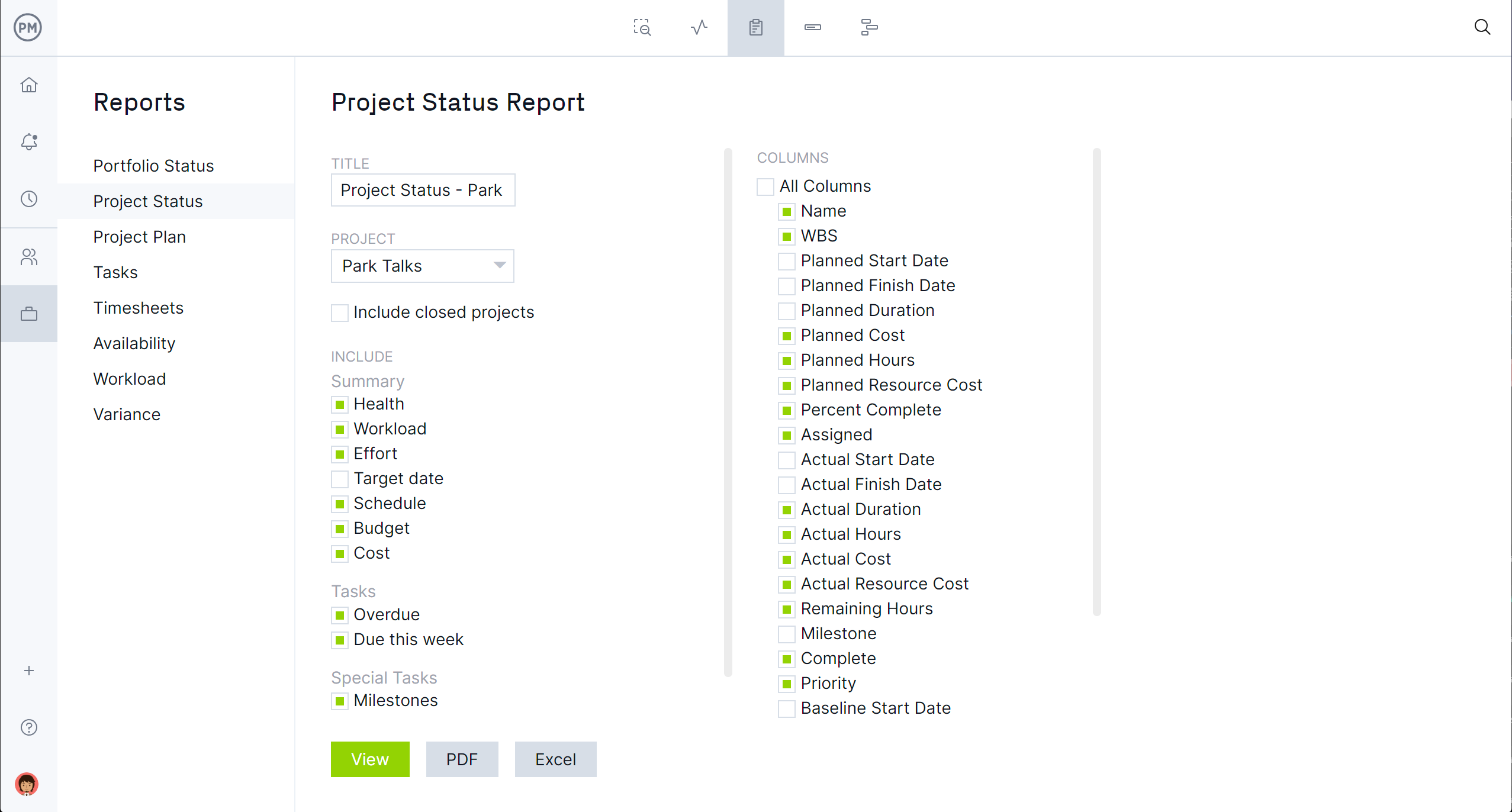
Related Stakeholder Management Content
These stakeholder map examples illustrate how stakeholder management works. For those curious to learn more about this topic, check out the links below. There are more free templates, definitions and types of stakeholders, plus a lot of other insightful pieces.
- 13 Free Stakeholder Management Templates for Excel & Word
- What Is a Stakeholder? Definitions, Types & Examples
- Stakeholder Mapping 101: How to Make a Stakeholder Map
- How to Make a Stakeholder Management Plan
- Stakeholder Analysis 101 (Example & Template Included)
- Top 10 Stakeholder Management Skills for Project Managers
- Stakeholder Salience Model in Project Management
ProjectManager is online project and portfolio management software that connects teams and stakeholders wherever they are. They can share files, comment at the task level and stay updated with email and in-app notifications. Get started with ProjectManager today for free.

